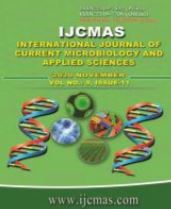


 National Academy of Agricultural Sciences (NAAS)
National Academy of Agricultural Sciences (NAAS)

|
PRINT ISSN : 2319-7692
Online ISSN : 2319-7706 Issues : 12 per year Publisher : Excellent Publishers Email : editorijcmas@gmail.com / submit@ijcmas.com Editor-in-chief: Dr.M.Prakash Index Copernicus ICV 2018: 95.39 NAAS RATING 2020: 5.38 |
Millets belong to the group of C4 grasses, which incorporate agronomically important crops such as sorghum and maize, bioenergy crops including sugarcane and miscanthus, and nutri-cereals such as millets. Millets are considered as nutri-cereals because they are plentiful in carbohydrates, dietary fibers, proteins, fat and minerals like iron and calcium. These nutri-cereals are well known for their climate-resilient feature including adaptation to a wide range of ecological conditions, less water demand and less dependence on synthetic fertilizers. Millets possess several morpho-physiological, molecular and biochemical traits confer better tolerance to changing climate. Short life-cycle (seed to seed) in millet helps in escaping from stress. Traits responsible for evading stress conditions include short stature, small leaf area, thickened cell wall and capability to form dense root system. In the C4 framework, CO2 is concentrated around the enzyme ribulose-1,5-bisphosphate carboxylase oxygenase (RuBISCO) suppressing ribulose-1,5-bisphosphate (RuBP) oxygenation and photorespiration. Since RuBISCO of C4 plants works at elevated CO2 levels, millets have improved photosynthetic rates at warm conditions and presents prompt water use efficiency (WUE) and nitrogen use efficiency (NUE) which are 1.5 to 4-fold higher than C3 photosynthesis. Challenge to feed the burgeoning global population combined with threats encountered by agricultural crops due to changing climate emphasize on the urgency to exploit the beneficial characteristics of millets. Among millets, foxtail millet (Setaria italica) and its wild progenitor, green foxtail (Setaria viridis) are widely studied since they are considered as models for discerning the traits related to C4 photosynthesis, stress biology and bioenergy traits. In the present scenario of climate change, temperature rise leads to reduction in the yield of millets whereas irregular rainfall adds to this reduction with a negative impact. QTL mapping for different drought tolerance genes in millets will be helpful for breeding climate resilient genotypes. Similarly QTLs for significant general combining ability (GCA) and specific combining ability (SCA) for several yield related traits under stress will also proved to be beneficial for breeding for climate resilience. Stress resistance genes can be incorporated into the genetic background of desired genotypes with marker assisted back crossing and gene pyramiding technique as well as genetic engineering in order to develop climate-resilient crop varieties.
 |
 |
 |
 |
 |